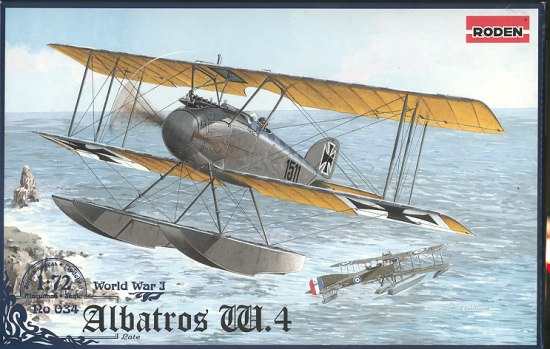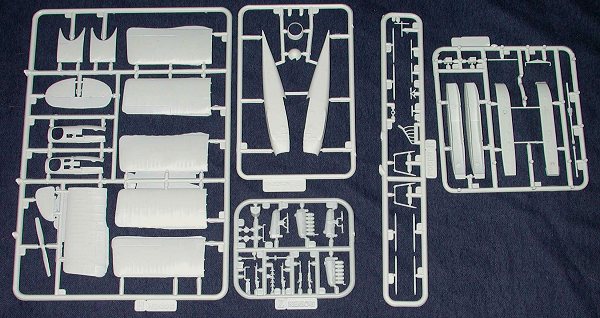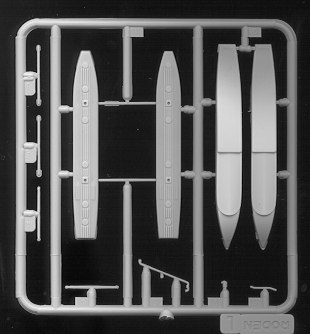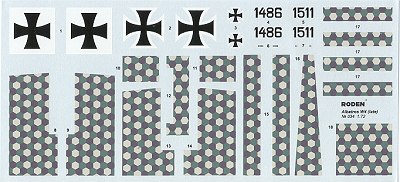
|
KIT: |
Roden 1/72 Albatros W.4 (Late) |
|
KIT # |
034 |
|
PRICE: |
$8.98 ($7.96 at Squadron) |
|
DECALS: |
three aircraft |
|
REVIEWER: |
|
|
NOTES: |

|
HISTORY |
Allow me to quote from the Roden website for this one.
|
THE KIT |

 The vast majority
of this kit is exactly the same as what was reviewed in the early W4. The only
real difference in sprues is that this one has the later floats in place of the
earlier ones that are given in the previous kit. That sprue is shown to the
left. The level of flash seems a bit lower on this kit as well, but that could
just be wishful thinking as the wings sprue has been used for a number of
Albatros D.I / D.II versions as well as the earlier W.4.
The vast majority
of this kit is exactly the same as what was reviewed in the early W4. The only
real difference in sprues is that this one has the later floats in place of the
earlier ones that are given in the previous kit. That sprue is shown to the
left. The level of flash seems a bit lower on this kit as well, but that could
just be wishful thinking as the wings sprue has been used for a number of
Albatros D.I / D.II versions as well as the earlier W.4.
As with all Roden kits, the instructions are superb, offering a parts
location, a good painting guide using Humbrol paint references and there is a
well done rigging diagram included as well, something that is paramount when
doing these early aircraft. Markings are provided for two aircraft, both with
lozenge upper surfaces and matte sea grey sides. The undersurfaces of the wings and tail planes are in matte linen. The only
difference between them is the serial number. In fact, 1511 is not shown on the
painting/decal placement guide. The guide in the instructions and the full color
one on the back of the box are identical. The decals themselves
are very nicely printed and appear to be quite thin. It is great that
Roden provides the lozenge as I do believe it will be difficult to find and I
just can't imagine having to paint all of those hexagons!
undersurfaces of the wings and tail planes are in matte linen. The only
difference between them is the serial number. In fact, 1511 is not shown on the
painting/decal placement guide. The guide in the instructions and the full color
one on the back of the box are identical. The decals themselves
are very nicely printed and appear to be quite thin. It is great that
Roden provides the lozenge as I do believe it will be difficult to find and I
just can't imagine having to paint all of those hexagons!
|
CONCLUSIONS |
I'm sure that WWI aircraft fans will be very pleased with this kit. There have been kits of this plane done before by Merlin, Aeroclub and Pegasus. However, those were all short run kits and this one is as close to mainstream as you will find. I think all who build this one will be quite happy with it.
Thanks to the fine folks at
 for the review kit. Visit
them by clicking on the logo.
for the review kit. Visit
them by clicking on the logo.
You can find this kit and many others at

If you would like your product reviewed fairly and fairly quickly by a site that has over 200,000 visitors a month, please contact me or see other details in the Note to Contributors.